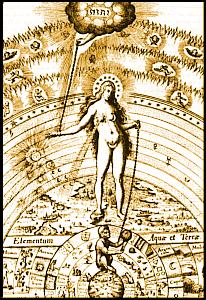|
The Windstar Season: A 73-Day
Alchemical Spiritual Framework
 The Windstar
Season, part of the 5 Mt System of Miryai, is a 73-day spiritual system
rooted in the wisdom of African, European, and American traditions, beginning
on the first new or full moon between June 1 and June 16. It consists of
five 15 day fortnights, each aligned with a phase of the moon and one of
five elemental themes and three stages of a 15-stage alchemical process,
interpreted through a Jungian lens as a path to psychological individuation,
embodied by the mythos of Sophia in Gnostic traditions. The system prioritizes
self-guided growth, using reflective practices and Sophia’s narrative to
foster transformation. Associated traditions provide minor contextual influence. The Windstar
Season, part of the 5 Mt System of Miryai, is a 73-day spiritual system
rooted in the wisdom of African, European, and American traditions, beginning
on the first new or full moon between June 1 and June 16. It consists of
five 15 day fortnights, each aligned with a phase of the moon and one of
five elemental themes and three stages of a 15-stage alchemical process,
interpreted through a Jungian lens as a path to psychological individuation,
embodied by the mythos of Sophia in Gnostic traditions. The system prioritizes
self-guided growth, using reflective practices and Sophia’s narrative to
foster transformation. Associated traditions provide minor contextual influence.
The Summer Session entails a fifteen stage unfolding
of:
-
The Alchemic-Jungian spiritual system
-
Spiritual history of the African-European region.
-
Spiritual practices and rituals of its esoteric traditions
-
The Mythos of Sophia the archetype of enlightenment
from this region.
The Five Fortnights
 Each fortnight
focuses on three stages of the 15-stage alchemical process, an elemental
theme, and a segment of Sophia’s mythos, with associated traditions as
secondary influences. A brief overview of the alchemical area covered is
included. Each fortnight
focuses on three stages of the 15-stage alchemical process, an elemental
theme, and a segment of Sophia’s mythos, with associated traditions as
secondary influences. A brief overview of the alchemical area covered is
included.
1. Wind+Wind: Initial Purification (June 1–15)
- Focus: Stages 1–3 (Preparation, Calcination, Dissolution)
initiate transformation by setting intentions, dismantling the ego, and
releasing repressed emotions, aligned with the wind element. Influenced
by Gnostic Sethites and Isis Cult.
- Alchemical Area: Preliminaries—establishing intent,
confronting the shadow, and dissolving psychological barriers to prepare
for individuation.
- Sophia’s Mythos: Her emanation from the Pleroma and
desire to create mirror the initial call to self-discovery.
2. Wind+Zephyr: Discernment and Integration (June 16–30)
- Focus: Stages 4–6 (Separation, Conjunction, Putrefaction)
emphasize isolating core aspects of the psyche, uniting opposites, and
facing the shadow’s depths, aligned with the zephyr element. Influenced
by Neo-Platonism and early Monasticism.
- Alchemical Area: Differentiation and Unification—separating
true from false self, integrating ego and shadow, and confronting psychological
depths for rebirth.
- Sophia’s Mythos: Her creation of an imperfect form and
entrapment in Chaos reflect confronting and integrating inner conflicts.
3. Wind+Earth: Awakening Transformation (July 1–15)
- Focus: Stages 7–9 (Fermentation, Distillation, Coagulation)
spark higher consciousness, refine insights, and ground them into a stable
personality, aligned with the earth element. Influenced by Medieval Alchemists
and Carmelite Monastics.
- Alchemical Area: Awakening and Refinement—igniting spiritual
growth through inspiration, purifying insights, and stabilizing psychological
progress.
- Sophia’s Mythos: Her rescue by a savior and unveiling
of light mirror the awakening of higher awareness.
4. Wind+Water: Deepening Integration (July 16–30)
- Focus: Stages 10–12 (Sublimation, Solution, Ceration)
elevate instincts, revisit unconscious material, and cultivate psychological
flexibility, aligned with the water element. Influenced by Rosicrucians
and Hildegard of Bingen.
- Alchemical Area: Elevation and Flexibility—transforming
base impulses, deepening purification, and fostering adaptability for continued
growth.
- Sophia’s Mythos: Her guidance of humanity through Zoe
reflects deepening integration and sharing wisdom.
5. Wind+Fire: Full Individuation (July 31–August 12)
- Focus: Stages 13–15 (Fixation, Multiplication, Projection)
solidify lasting change, amplify transformative power, and manifest the
individuated Self, aligned with the fire element. Influenced by Jungian
psychology. For details, see [15-Stage Alchemical Process](#15-stage-alchemical-process).
- Alchemical Area: Culmination and Manifestation—establishing
permanent psychological change, extending influence to others, and living
as a fully integrated Self.
- Sophia’s Mythos: Her glorification and union with the
Anointed embody complete individuation.
Sophia’s Mythos
Sophia, a Gnostic archetype of enlightenment, is the spiritual model
of the Windstar Season. Emerging from the divine Pleroma, she sought to
create independently, fell into Chaos, and was redeemed, guiding humanity
toward wisdom. Her journey from error to glorification parallels the 15-stage
alchemical process, reflecting the path to individuation. Her story aligns
with each fortnight’s stages. For her full narrative, see [Sophia’s Mythos](#sophia-mythos).
Historical Context
The Windstar Season centers on the alchemical process, interpreted through
Jungian psychology and linked to Sophia’s Gnostic mythos, with minor influences
from traditions like Gnosticism and Monasticism. These provide contextual
support for the 15-stage process and elemental framework. For a detailed
historical overview, see [Historical Context](#historical-context).
Implementation
The season begins on the first new or full moon between June 1 and June
16, with fortnights starting every 14 days. Practitioners engage in daily
reflective practices, focusing on the elemental theme and three stages
of the alchemical process, as detailed in linked resources. The system
requires only commitment to daily engagement.
Starts between Jun 1-Jun 16 (1st
new or full moon) Season: Summer
with 5 Fortnights.
Links for Further Reading
Notes
|

 Each fortnight
focuses on three stages of the 15-stage alchemical process, an elemental
theme, and a segment of Sophia’s mythos, with associated traditions as
secondary influences. A brief overview of the alchemical area covered is
included.
Each fortnight
focuses on three stages of the 15-stage alchemical process, an elemental
theme, and a segment of Sophia’s mythos, with associated traditions as
secondary influences. A brief overview of the alchemical area covered is
included.